

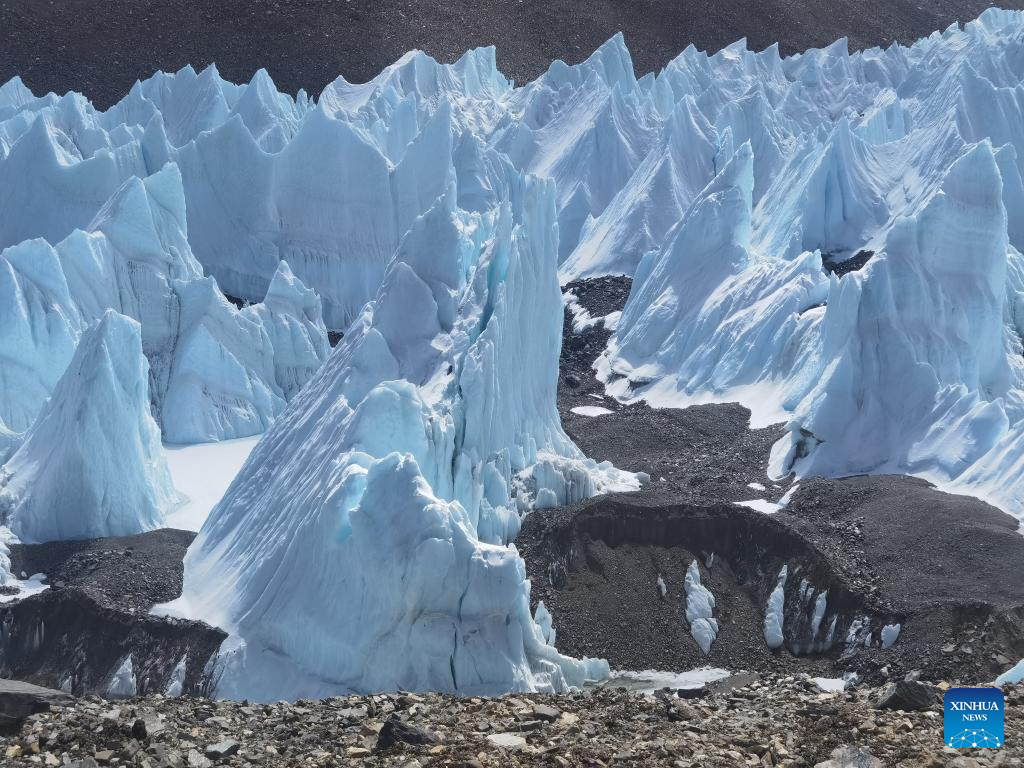
Photo taken with a mobile phone shows a view of the East Rongbuk glacier on Mount Qomolangma, May 6, 2022. The new comprehensive scientific expedition on Mount Qomolangma, as part of China's second scientific research survey of the Qinghai-Tibet Plateau, is the country's first scientific research above an altitude of 8,000 meters on the peak.
More than 270 scientific research members from five teams are participating in the expedition.
The glacier and pollutant research team led by Kang Shichang, a researcher with the Northwest Institute of Eco-Environment and Resources under the Chinese Academy of Sciences (CAS), will monitor pollutants, the Rongbuk glacier and ice lake changes, as well as the greenhouse gas emissions from rivers and lakes covering the high-altitude area from the Mount Qomolangma base camp to the East Rongbuk glacier. (Xinhua)
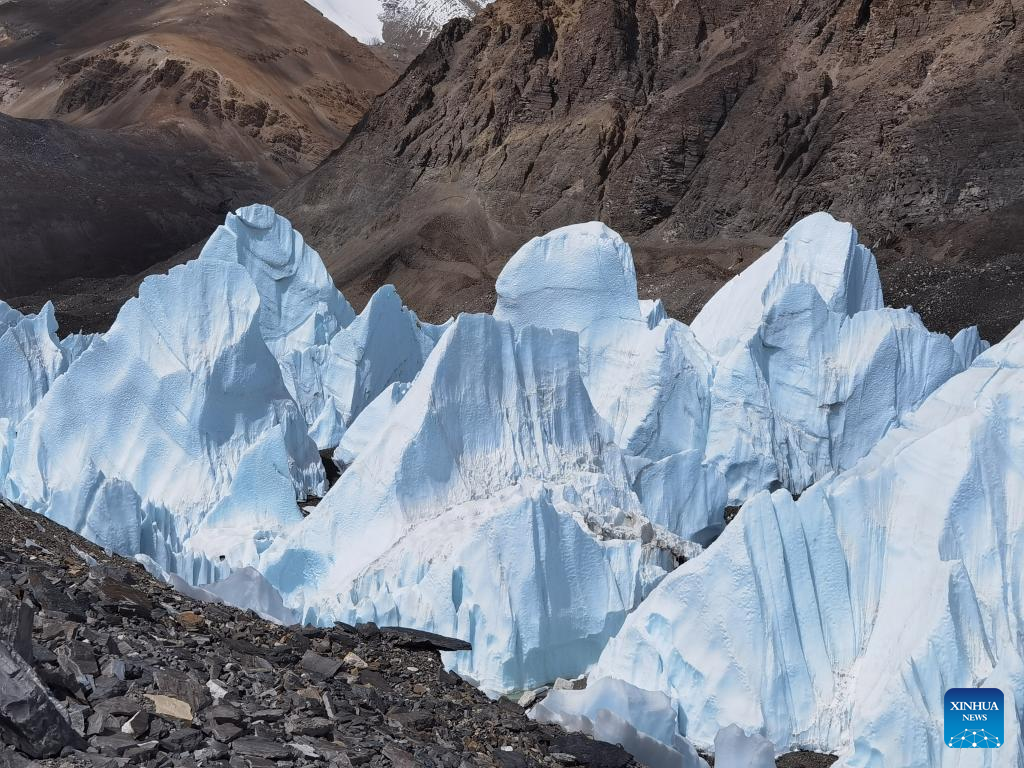
Photo taken with a mobile phone shows a view of the East Rongbuk glacier on Mount Qomolangma, May 7, 2022. The new comprehensive scientific expedition on Mount Qomolangma, as part of China's second scientific research survey of the Qinghai-Tibet Plateau, is the country's first scientific research above an altitude of 8,000 meters on the peak.
More than 270 scientific research members from five teams are participating in the expedition.
The glacier and pollutant research team led by Kang Shichang, a researcher with the Northwest Institute of Eco-Environment and Resources under the Chinese Academy of Sciences (CAS), will monitor pollutants, the Rongbuk glacier and ice lake changes, as well as the greenhouse gas emissions from rivers and lakes covering the high-altitude area from the Mount Qomolangma base camp to the East Rongbuk glacier. (Xinhua)
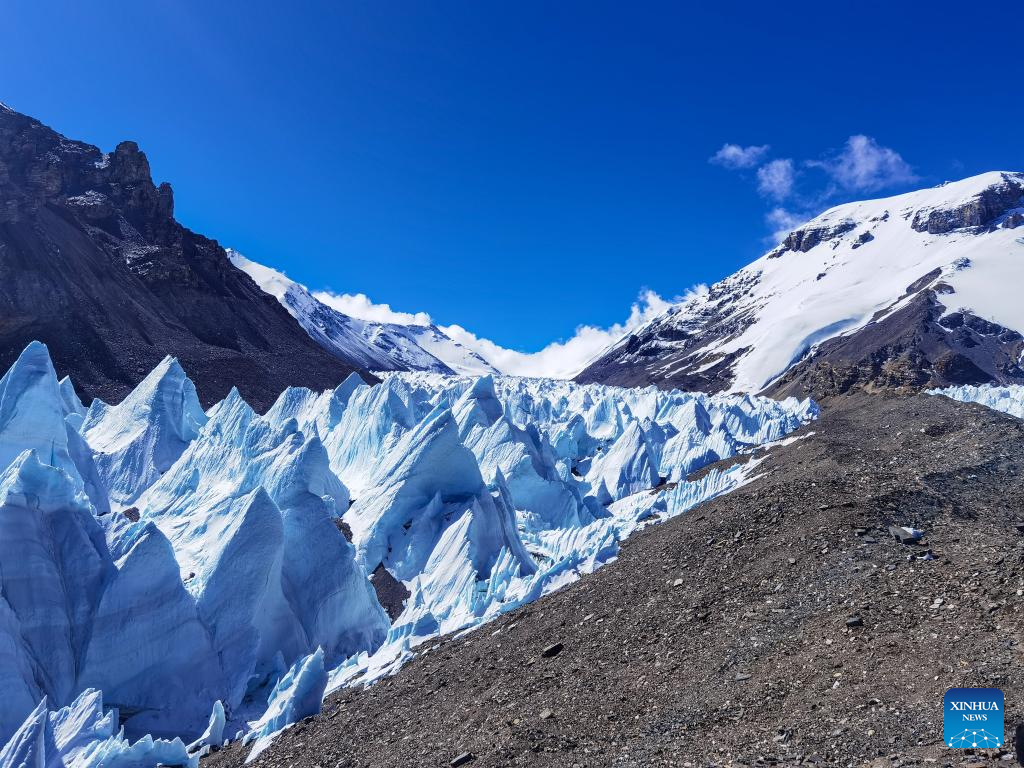
Photo taken with a mobile phone shows a view of the East Rongbuk glacier on Mount Qomolangma, May 6, 2022. The new comprehensive scientific expedition on Mount Qomolangma, as part of China's second scientific research survey of the Qinghai-Tibet Plateau, is the country's first scientific research above an altitude of 8,000 meters on the peak.
More than 270 scientific research members from five teams are participating in the expedition.
The glacier and pollutant research team led by Kang Shichang, a researcher with the Northwest Institute of Eco-Environment and Resources under the Chinese Academy of Sciences (CAS), will monitor pollutants, the Rongbuk glacier and ice lake changes, as well as the greenhouse gas emissions from rivers and lakes covering the high-altitude area from the Mount Qomolangma base camp to the East Rongbuk glacier. (Xinhua)
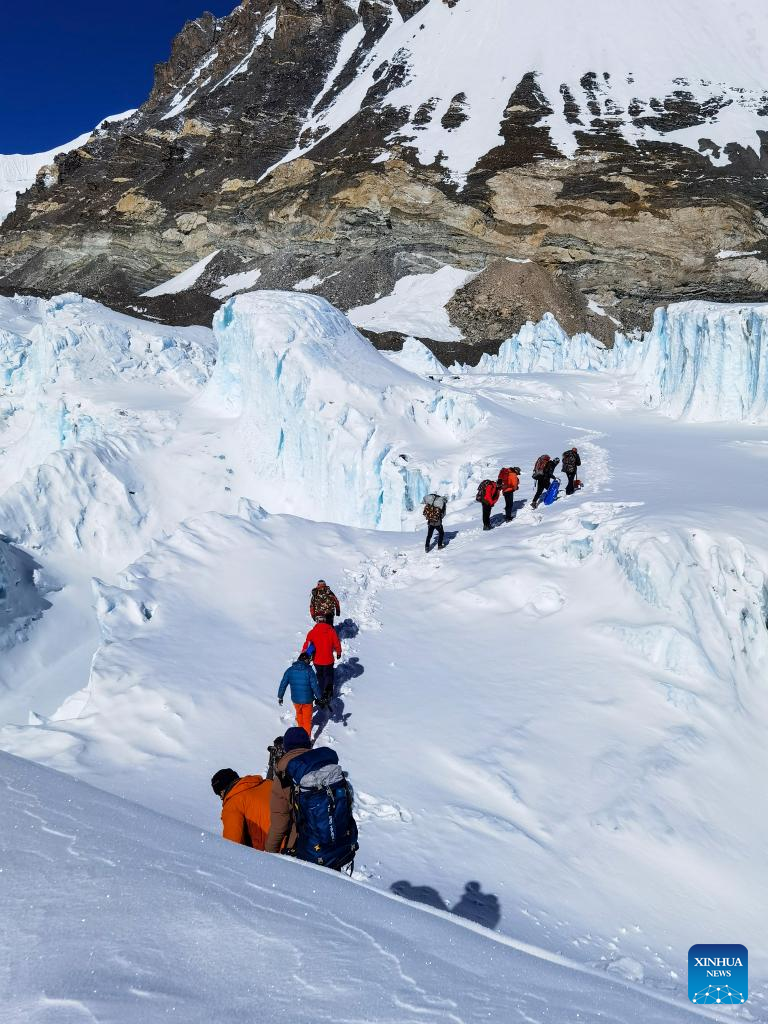
Photo taken with a mobile phone shows members of the glacier and pollutant research team walking past the East Rongbuk glacier on Mount Qomolangma, May 7, 2022. The new comprehensive scientific expedition on Mount Qomolangma, as part of China's second scientific research survey of the Qinghai-Tibet Plateau, is the country's first scientific research above an altitude of 8,000 meters on the peak.
More than 270 scientific research members from five teams are participating in the expedition.
The glacier and pollutant research team led by Kang Shichang, a researcher with the Northwest Institute of Eco-Environment and Resources under the Chinese Academy of Sciences (CAS), will monitor pollutants, the Rongbuk glacier and ice lake changes, as well as the greenhouse gas emissions from rivers and lakes covering the high-altitude area from the Mount Qomolangma base camp to the East Rongbuk glacier. (Xinhua)
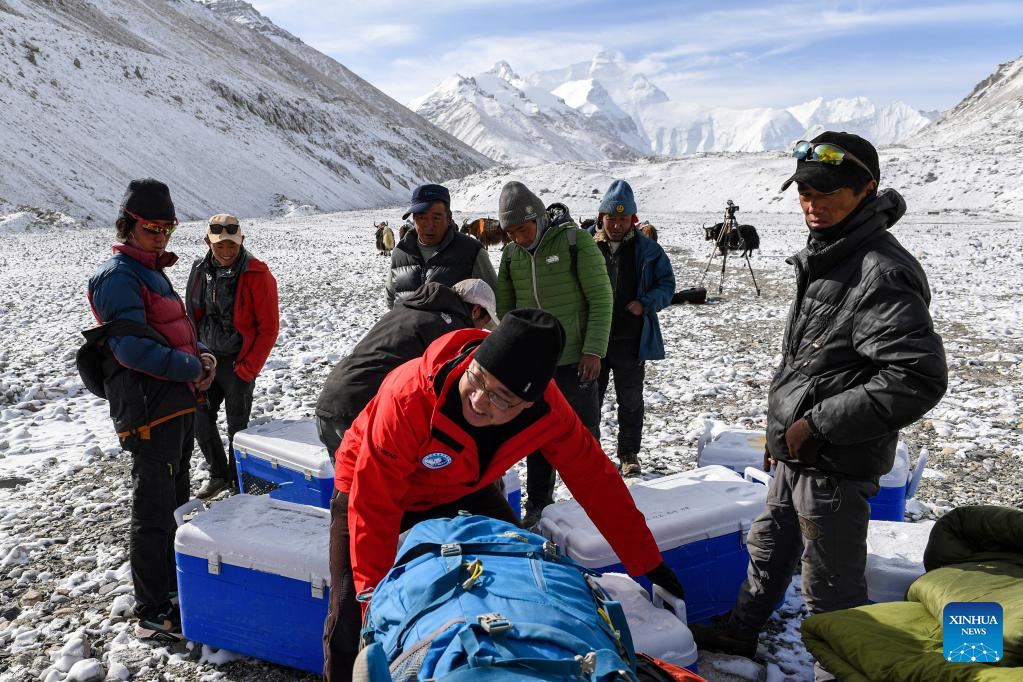
Kang Shichang (front) checks the working materials on Mount Qomolangma, May 6, 2022. The new comprehensive scientific expedition on Mount Qomolangma, as part of China's second scientific research survey of the Qinghai-Tibet Plateau, is the country's first scientific research above an altitude of 8,000 meters on the peak.
More than 270 scientific research members from five teams are participating in the expedition.
The glacier and pollutant research team led by Kang Shichang, a researcher with the Northwest Institute of Eco-Environment and Resources under the Chinese Academy of Sciences (CAS), will monitor pollutants, the Rongbuk glacier and ice lake changes, as well as the greenhouse gas emissions from rivers and lakes covering the high-altitude area from the Mount Qomolangma base camp to the East Rongbuk glacier. (Xinhua/Jiang Fan)
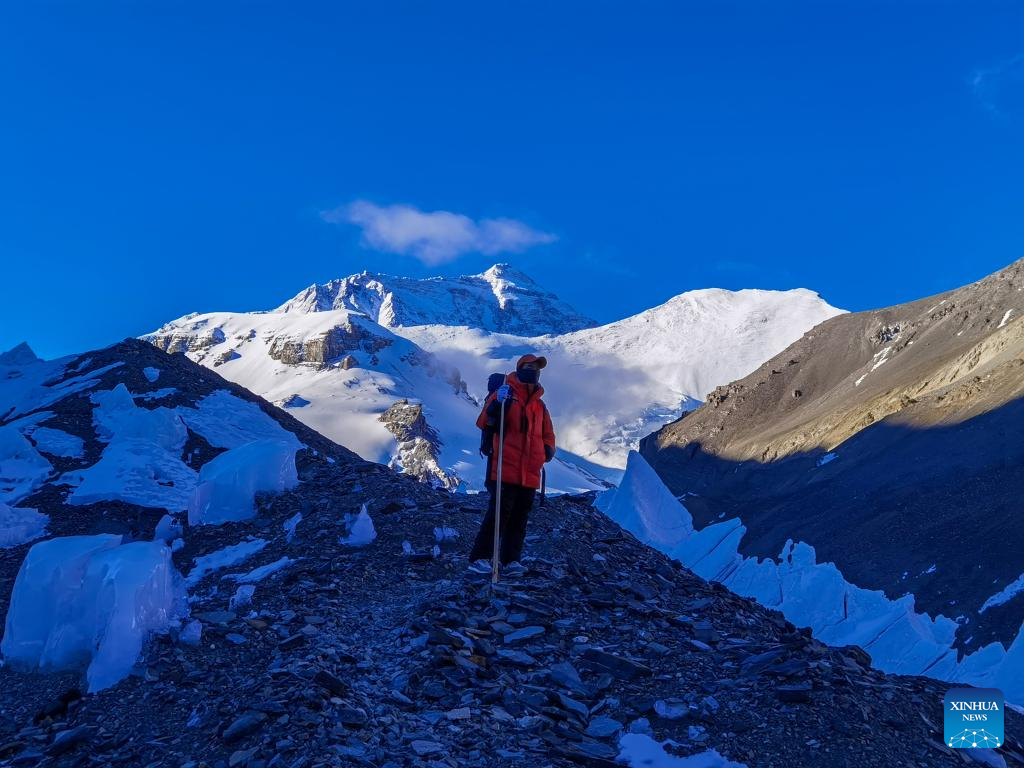
Photo taken with a mobile phone shows a member of the glacier and pollutant research team working at the East Rongbuk glacier on Mount Qomolangma, May 6, 2022. The new comprehensive scientific expedition on Mount Qomolangma, as part of China's second scientific research survey of the Qinghai-Tibet Plateau, is the country's first scientific research above an altitude of 8,000 meters on the peak.
More than 270 scientific research members from five teams are participating in the expedition.
The glacier and pollutant research team led by Kang Shichang, a researcher with the Northwest Institute of Eco-Environment and Resources under the Chinese Academy of Sciences (CAS), will monitor pollutants, the Rongbuk glacier and ice lake changes, as well as the greenhouse gas emissions from rivers and lakes covering the high-altitude area from the Mount Qomolangma base camp to the East Rongbuk glacier. (Xinhua)
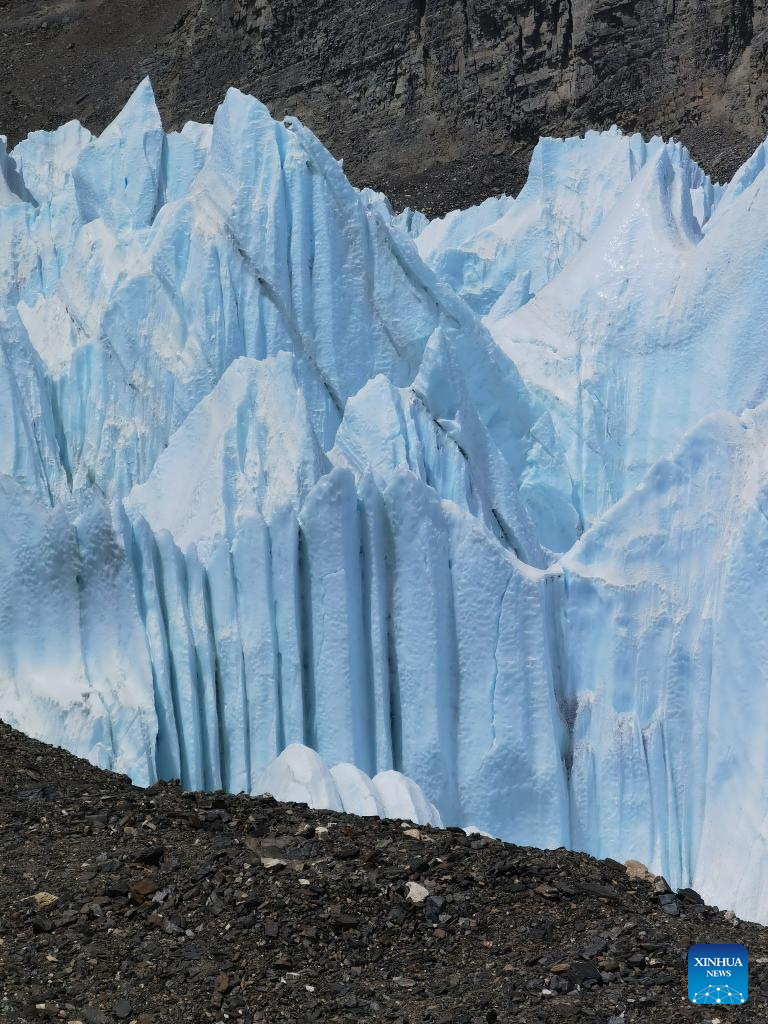
Photo taken with a mobile phone shows a view of the East Rongbuk glacier on Mount Qomolangma, May 7, 2022. The new comprehensive scientific expedition on Mount Qomolangma, as part of China's second scientific research survey of the Qinghai-Tibet Plateau, is the country's first scientific research above an altitude of 8,000 meters on the peak.
More than 270 scientific research members from five teams are participating in the expedition.
The glacier and pollutant research team led by Kang Shichang, a researcher with the Northwest Institute of Eco-Environment and Resources under the Chinese Academy of Sciences (CAS), will monitor pollutants, the Rongbuk glacier and ice lake changes, as well as the greenhouse gas emissions from rivers and lakes covering the high-altitude area from the Mount Qomolangma base camp to the East Rongbuk glacier. (Xinhua)
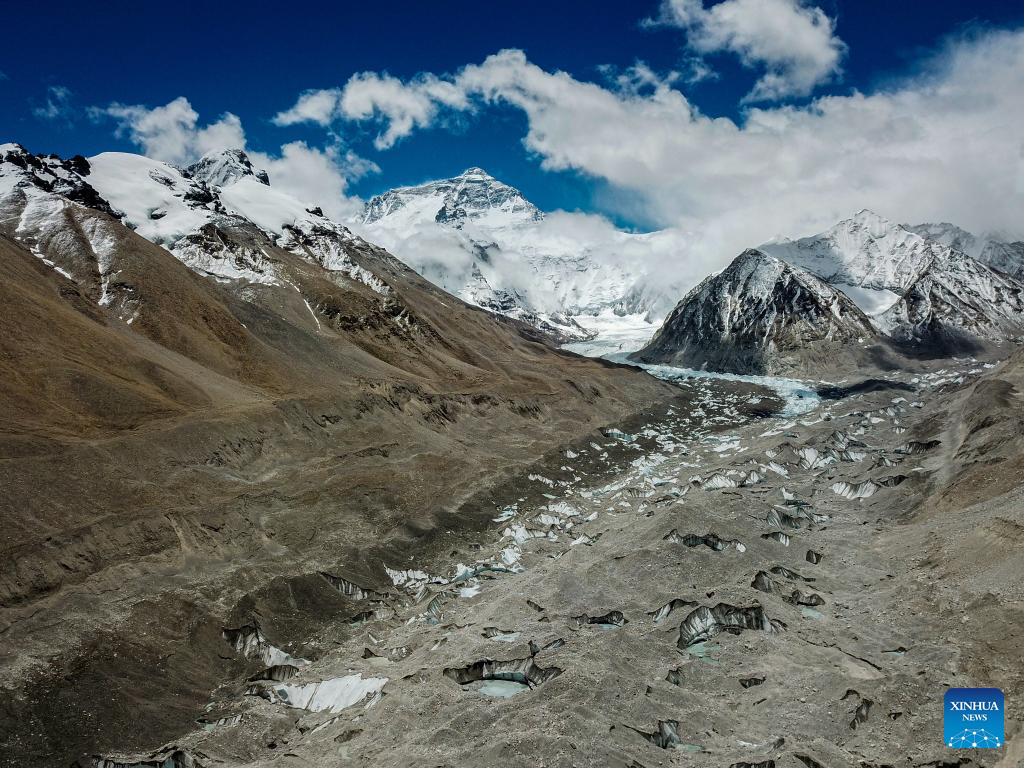
Aerial photo shows a view of the East Rongbuk glacier on Mount Qomolangma, May 8, 2022. The new comprehensive scientific expedition on Mount Qomolangma, as part of China's second scientific research survey of the Qinghai-Tibet Plateau, is the country's first scientific research above an altitude of 8,000 meters on the peak.
More than 270 scientific research members from five teams are participating in the expedition.
The glacier and pollutant research team led by Kang Shichang, a researcher with the Northwest Institute of Eco-Environment and Resources under the Chinese Academy of Sciences (CAS), will monitor pollutants, the Rongbuk glacier and ice lake changes, as well as the greenhouse gas emissions from rivers and lakes covering the high-altitude area from the Mount Qomolangma base camp to the East Rongbuk glacier. (Xinhua/Jiang Fan)
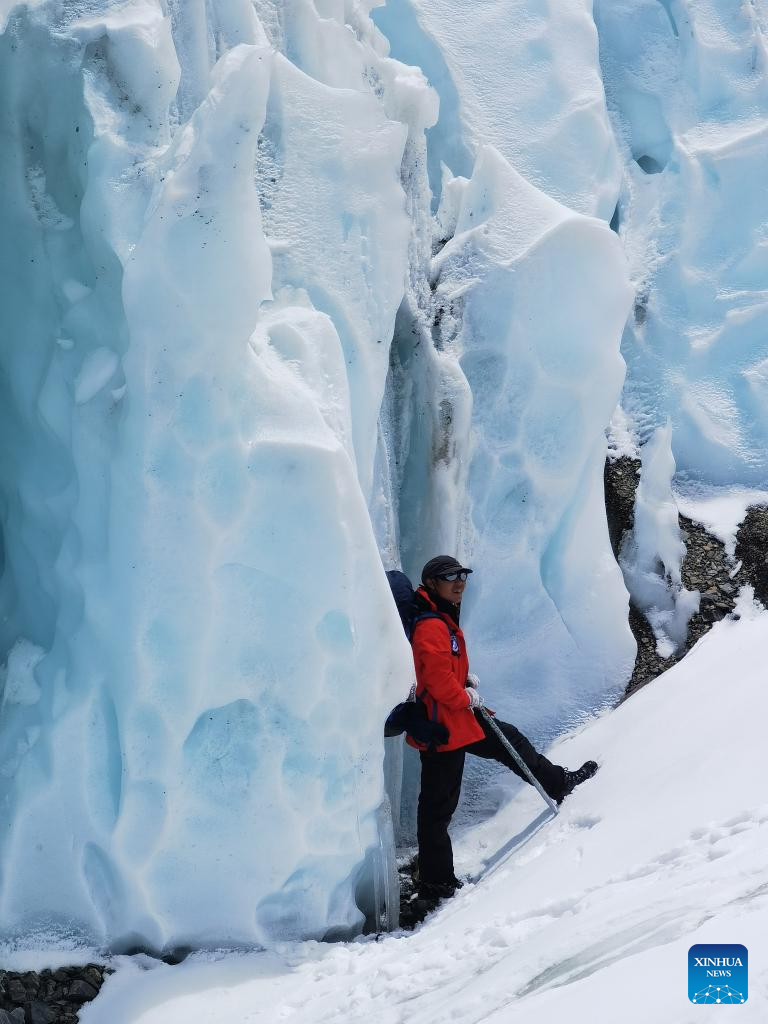
Photo taken with a mobile phone shows a member of the glacier and pollutant research team walking past the East Rongbuk glacier on Mount Qomolangma, May 6, 2022. The new comprehensive scientific expedition on Mount Qomolangma, as part of China's second scientific research survey of the Qinghai-Tibet Plateau, is the country's first scientific research above an altitude of 8,000 meters on the peak.
More than 270 scientific research members from five teams are participating in the expedition.
The glacier and pollutant research team led by Kang Shichang, a researcher with the Northwest Institute of Eco-Environment and Resources under the Chinese Academy of Sciences (CAS), will monitor pollutants, the Rongbuk glacier and ice lake changes, as well as the greenhouse gas emissions from rivers and lakes covering the high-altitude area from the Mount Qomolangma base camp to the East Rongbuk glacier. (Xinhua)
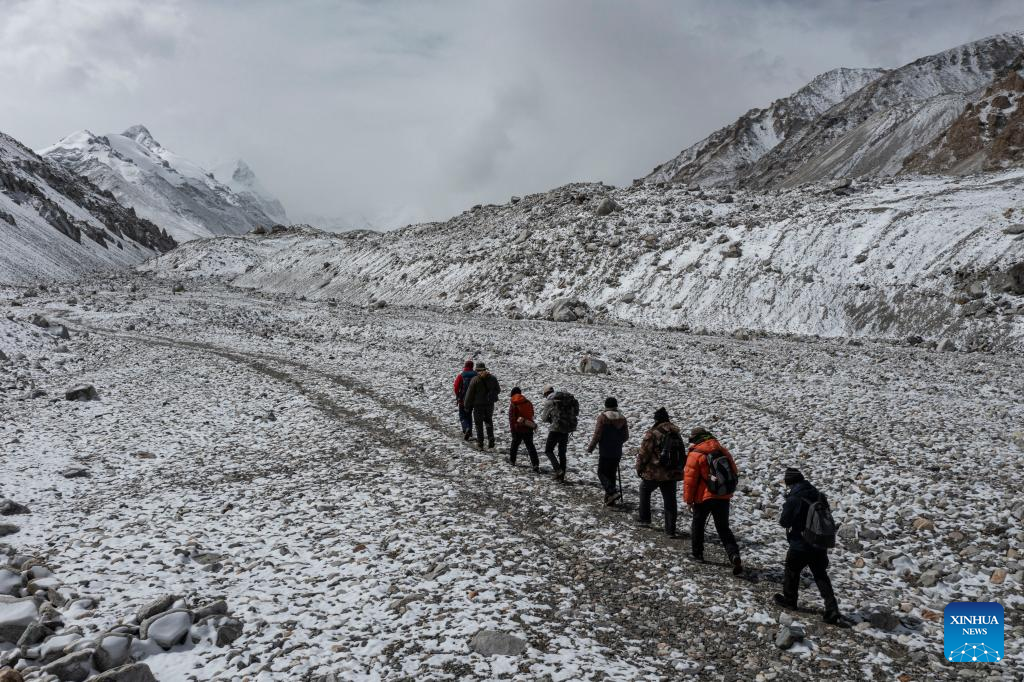
Aerial photo taken on May 1, 2022 shows members of the glacier and pollutant research team heading for the East Rongbuk glacier on Mount Qomolangma. The new comprehensive scientific expedition on Mount Qomolangma, as part of China's second scientific research survey of the Qinghai-Tibet Plateau, is the country's first scientific research above an altitude of 8,000 meters on the peak.
More than 270 scientific research members from five teams are participating in the expedition.
The glacier and pollutant research team led by Kang Shichang, a researcher with the Northwest Institute of Eco-Environment and Resources under the Chinese Academy of Sciences (CAS), will monitor pollutants, the Rongbuk glacier and ice lake changes, as well as the greenhouse gas emissions from rivers and lakes covering the high-altitude area from the Mount Qomolangma base camp to the East Rongbuk glacier. (Xinhua/Sun Fei)
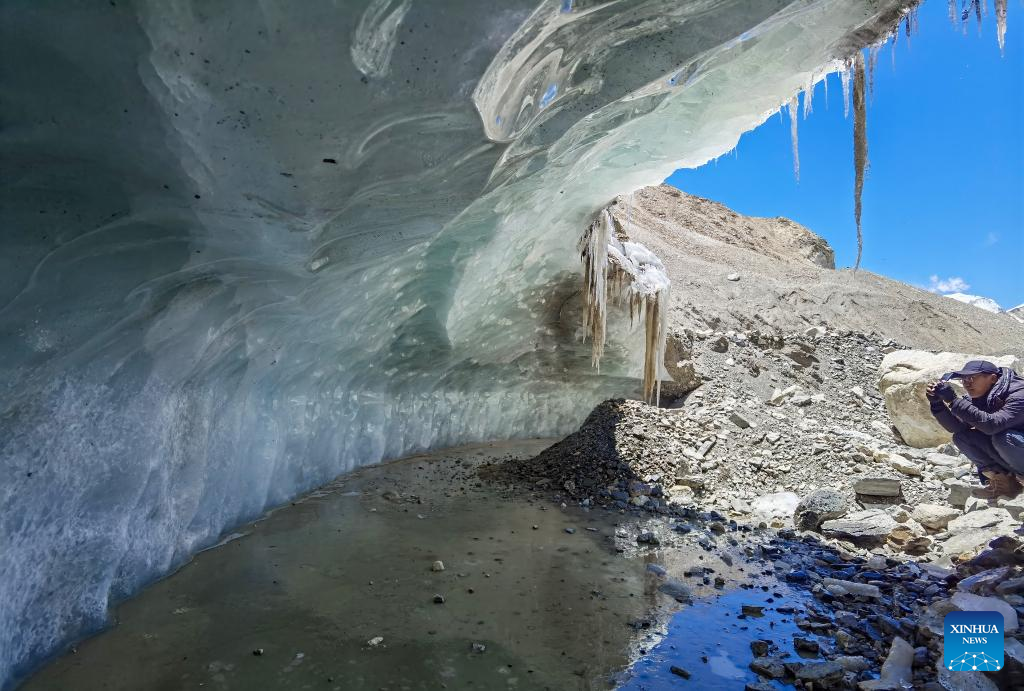
Photo taken with a mobile phone shows a member of the glacier and pollutant research team working at the East Rongbuk glacier on Mount Qomolangma, May 5, 2022. The new comprehensive scientific expedition on Mount Qomolangma, as part of China's second scientific research survey of the Qinghai-Tibet Plateau, is the country's first scientific research above an altitude of 8,000 meters on the peak.
More than 270 scientific research members from five teams are participating in the expedition.
The glacier and pollutant research team led by Kang Shichang, a researcher with the Northwest Institute of Eco-Environment and Resources under the Chinese Academy of Sciences (CAS), will monitor pollutants, the Rongbuk glacier and ice lake changes, as well as the greenhouse gas emissions from rivers and lakes covering the high-altitude area from the Mount Qomolangma base camp to the East Rongbuk glacier. (Xinhua)
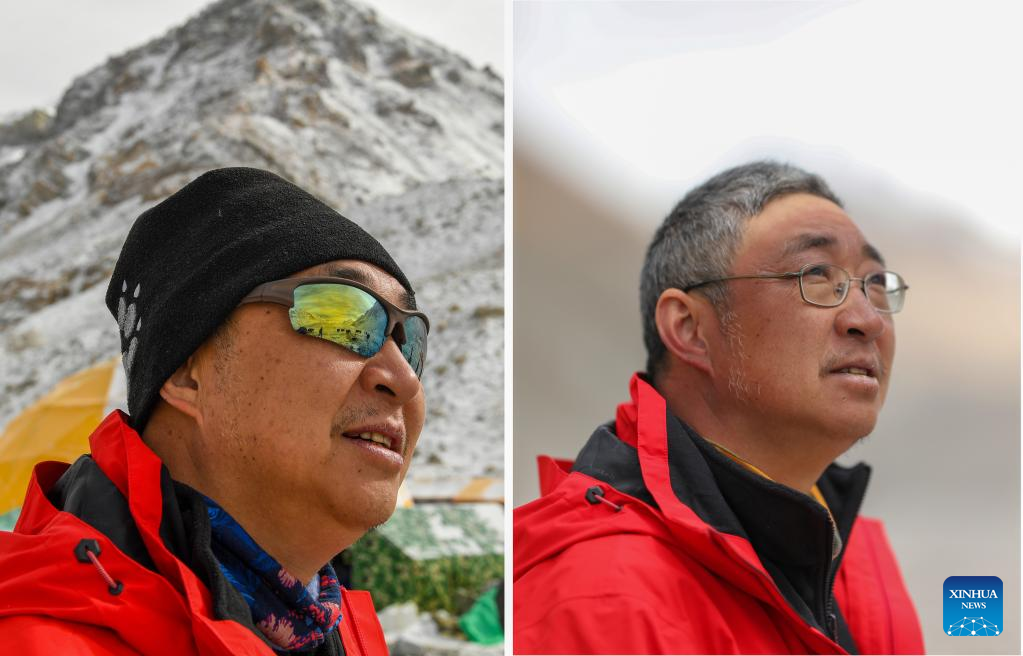
Combo photo shows Kang Shichang before the research (L) taken on May 1, 2022; and Kang Shichang after a research task of East Rongbuk glacier on Mount Qomolangma taken on May 9, 2022. The new comprehensive scientific expedition on Mount Qomolangma, as part of China's second scientific research survey of the Qinghai-Tibet Plateau, is the country's first scientific research above an altitude of 8,000 meters on the peak.
More than 270 scientific research members from five teams are participating in the expedition.
The glacier and pollutant research team led by Kang Shichang, a researcher with the Northwest Institute of Eco-Environment and Resources under the Chinese Academy of Sciences (CAS), will monitor pollutants, the Rongbuk glacier and ice lake changes, as well as the greenhouse gas emissions from rivers and lakes covering the high-altitude area from the Mount Qomolangma base camp to the East Rongbuk glacier. (Xinhua/Jiang Fan)

Photo taken with a mobile phone shows a view of the East Rongbuk glacier on Mount Qomolangma, May 6, 2022. The new comprehensive scientific expedition on Mount Qomolangma, as part of China's second scientific research survey of the Qinghai-Tibet Plateau, is the country's first scientific research above an altitude of 8,000 meters on the peak.
More than 270 scientific research members from five teams are participating in the expedition.
The glacier and pollutant research team led by Kang Shichang, a researcher with the Northwest Institute of Eco-Environment and Resources under the Chinese Academy of Sciences (CAS), will monitor pollutants, the Rongbuk glacier and ice lake changes, as well as the greenhouse gas emissions from rivers and lakes covering the high-altitude area from the Mount Qomolangma base camp to the East Rongbuk glacier. (Xinhua)
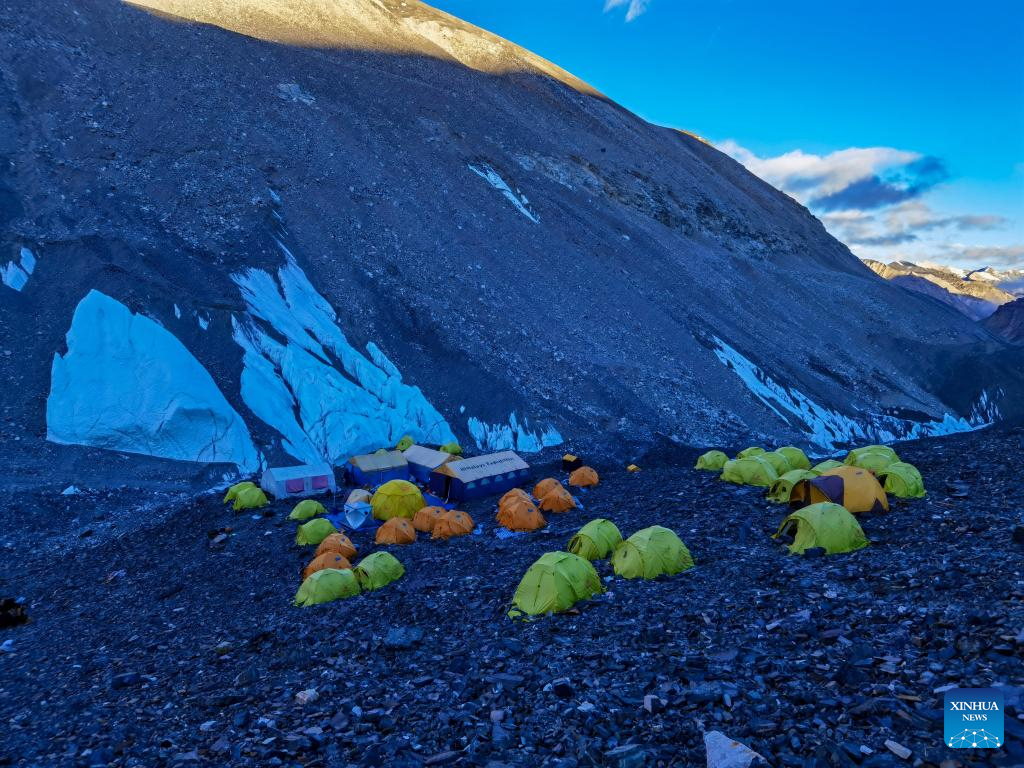
Photo taken with a mobile phone shows the base camp of the glacier and pollutant research team at an altitude of 5,800 meters on Mount Qomolangma, May 6, 2022. The new comprehensive scientific expedition on Mount Qomolangma, as part of China's second scientific research survey of the Qinghai-Tibet Plateau, is the country's first scientific research above an altitude of 8,000 meters on the peak.
More than 270 scientific research members from five teams are participating in the expedition.
The glacier and pollutant research team led by Kang Shichang, a researcher with the Northwest Institute of Eco-Environment and Resources under the Chinese Academy of Sciences (CAS), will monitor pollutants, the Rongbuk glacier and ice lake changes, as well as the greenhouse gas emissions from rivers and lakes covering the high-altitude area from the Mount Qomolangma base camp to the East Rongbuk glacier. (Xinhua)
点击右上角![]() 微信好友
微信好友
 朋友圈
朋友圈

请使用浏览器分享功能进行分享
